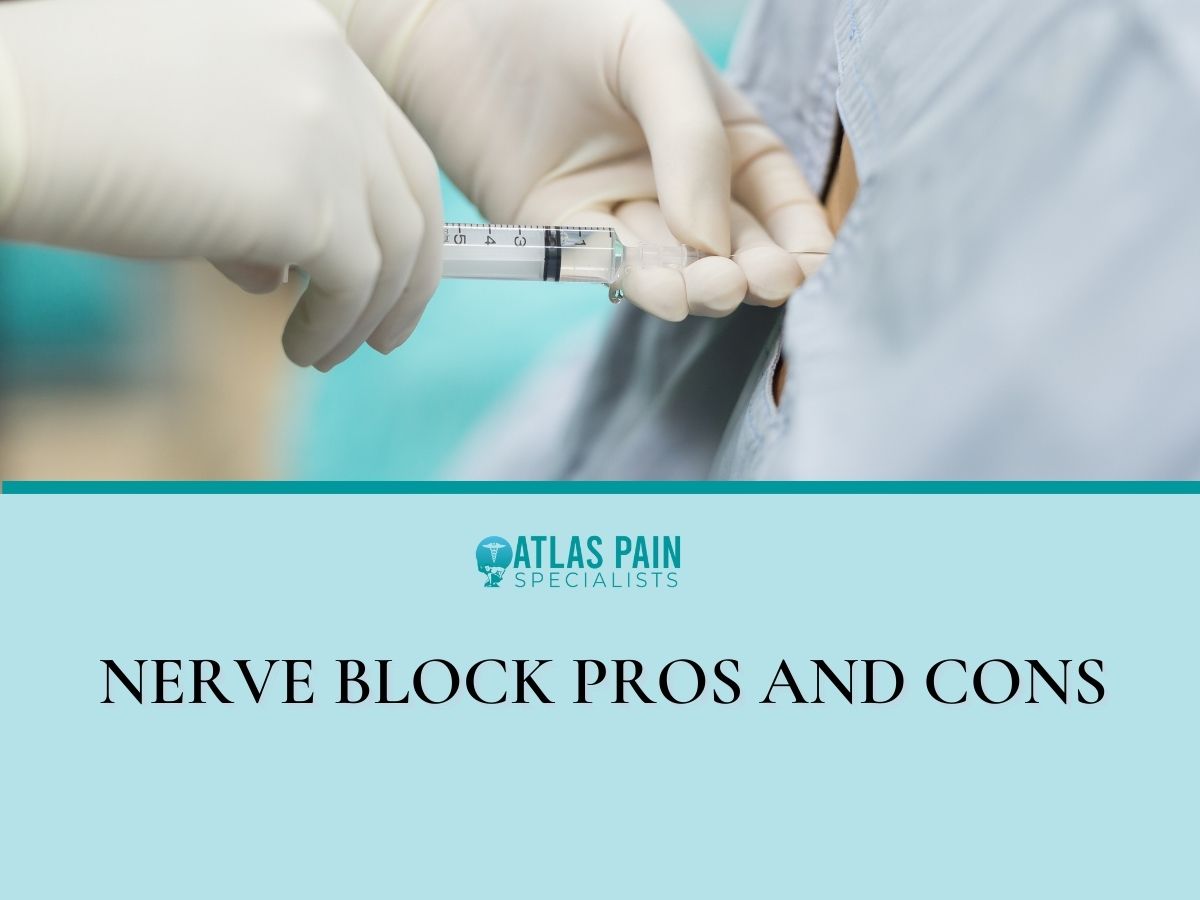

Nerve Block Pros and Cons:
When it comes to chronic pain, you or a loved one are looking for ways to alleviate it. More than 40 million persons in the United States suffer from "severe levels" of chronic pain, which makes ordinary tasks like getting out of bed, reaching for a glass of water in a kitchen cupboard, or rising from a seated to standing posture difficult.
If you fit this description, you may find that your world has shrunk to the space between your house and the drugstore and doctor's office where you formerly went about your daily business.
Chronic throbbing or scorching pain may be the result of complex regional pain syndrome if you've previously had a stroke, heart attack, surgery, or an injury to an arm or a leg. This pain can be alleviated by a nerve block but to do so you need to know the nerve block pros and cons.
Doctors aren't sure why this kind of pain occurs or how long it lasts. Another possibility is that your discomfort is caused by a problem of the back or another.
Taking leisurely walks, swing dance, tennis, or other sports you've done all your life may be out of the question. You're on the lookout for solutions that can help you rediscover the joy of living. You may be a candidate for nerve blocks, which might help ease your discomfort.
What exactly is a nerve block?

An injection of a local anesthetic or an anesthetic plus steroid into the painful location numbs the nearby nerves and alleviates the discomfort is known as a nerve block.
For some people, nerve blocks may be an integral element of their pain management and treatment plan.
Your physical performance should be improved so that you may do everyday tasks without help and once again feel pleasure free of discomfort.
Research
There is strong scientific backing for nerve blocks, regardless of how they are used.
For the great majority of chronic pain sufferers, peripheral nerve blocks reduced their discomfort by at least 50%, according to an investigation published in 2019. Importantly, these patients reported an improvement in their general well-being as a result of the nerve blocks they received.
A 2018 research on trigeminal neuralgia found that all individuals were pain-free immediately after the block, and many stayed pain-free for eight months after the block. For patients who have had hip and knee replacements, the outlook is much better.
Nerve blocks used during hip and knee replacements were associated with better results than those that did not employ them, according to the authors of the research, which included data on over a million patients. There were fewer complications, and patients spent less time in the hospital if any at all.
What types of conditions do nerve blocks treat?

Nerve blocks are often used to reduce pain during surgery. Chronic health disorders or injuries that damage, inflame, or irritate the nerves may also benefit from the usage of these products.
Spinal cord blocks, as well as excruciating pain in the arms, legs, neck, and buttocks, are typical uses for nerve blocks.
A nerve block may be an option for you and your healthcare practitioner if you are experiencing these sorts of pain:
- Pain during labor and delivery
- Pain after surgery
- Pain caused by cancer.
- Joint inflammation and discomfort
- Trigeminal neuralgia and other forms of severe face discomfort
- Back Pain
- Migraines and occipital neuralgia are two common types of headaches.
- A condition is known as chronic regional pain syndrome (CRPS) often known as CRPS,
What are the different types of nerve blocks?

Depending on where the pain is located in the body, there are a variety of treatment options. An exception to this rule is the peripheral nerve block, which is more often utilized.
When it comes to nerve blocks, these are the most prevalent methods used.
Doctors use this surgery to give you painkillers and steroids directly into the back of your skull in order to relieve your symptoms.
If you suffer from frequent headaches, you may want to consider this treatment. If you suffer from a headache like this, the occipital nerve block operation should provide you with immediate relief.
2. Genicular nerve block
A genicular nerve block is used to diagnose and treat chronic knee pain. A genicular nerve block often involves the injection of both a corticosteroid and a local anesthetic.
Knee injections might include one or more genicular nerves. The articular branches of the genicular nerves are referred to as anterior medial, superior lateral, and inner medial.
The genicular block injection blocks pain signals before they reach your brain by injecting a medication into the genicular nerve branches.
Nerve blocks of this kind may also be beneficial for those with chronic knee pain who aren't candidates for knee surgery. Additionally, physical therapy may be an option to assist reduce your symptoms.
3. Trigeminal nerve blocks
There are two trigeminal nerves on each side of your head immediately in front of your ears. Head, cheeks, nose, and jaw are all supplied by it.
When the trigeminal nerve is damaged, severe face pain may result, which is often referred to as trigeminal neuralgia.
Trigeminal nerve pain may be produced by even the tiniest of breezes. However, while the underlying reasons are investigated and addressed, temporary relief may be provided by a trigeminal nerve block.
4. Pudendal nerve block
Starting at the sacrum, the three branches of the pudendal nerve emerge from the rear of the pelvis. The rectum is served by one branch, while the perineum and the genitals are served by the other two.
Pelvic discomfort may be alleviated with a pudendal nerve block. Pain in this area may be caused by pudendal neuropathy, which is a general term for a variety of conditions, or it may be a result of childbirth or other trauma.
Additionally, this nerve might be affected by tumors or cysts pushing on it. A pudendal nerve block may also be used during this procedure.
There are intercostal nerves that run between and around the ribs. The upper chest, abdomen, muscles, and skin are all sensed by the diaphragm's sensory nerves.
A shingles infection, surgery (including a mastectomy), or any other post-operative pain may all cause discomfort.
Intercostal nerve blocks may be effective after only one treatment for many patients. As a result, the body is able to repair and recover more quickly and with less discomfort.
6. Peripheral nerve block
Peripheral nerves are responsible for movement, sensation, and motor control throughout the whole human body. Peripheral nerve blocks may be used to alleviate pain in a broader area of the human body.
To treat pain in a specific location of the body, peripheral nerve blocks target the nerves that provide signals to the brain. An excellent example of a peripheral nerve is the sciatic nerve.
A nerve that runs from the lumbar spine all the way across the buttocks, down the hip, and into the foot is the longest and broadest in the body. The sciatic nerve may be numbed using a peripheral nerve block to alleviate pain and other symptoms.
Surgical operations may also benefit from peripheral nerve blocks. Peripheral nerve blocks in anesthesia have been shown to speed up recovery from some procedures in the short term, according to research.
Continuous catheter nerve block is an option for patients with persistent peripheral nerve discomfort. For continuous treatment, they will insert a catheter beneath the skin near the afflicted nerves.
Nerve blocks on the stellate ganglion may be used to diagnose, but they can also be used to relieve discomfort. Using these sets of nerves, one may diagnose (and occasionally cure) pain in the head, neck, chest, and arms.
The stellate ganglion nerve is injected via the front of the neck, close to the side of the voice box, using this injection. Many more nerve blocks are available, such as celiac plexus and brachial plexus blocks, for the treatment of discomfort in the stomach or arms and shoulders, respectively.
Would a nerve block be beneficial to my condition?
Nerve blocks are an option if more conservative methods of treating persistent pain in the neck, spine, or back have failed. The use of nerve blocks may be beneficial for patients who have pain in a particular nerve or its root. During labor and delivery, the most frequent form of nerve block used by women is the epidural. After surgery, nerve blocks are also employed.
Nerve Block Pros & Cons

Nerve blocks are an effective treatment for persistent pain. There are a few nerve block pros and cons:
Nerve block pros include
- Prescription and over-the-counter medicines may be reduced by using nerve blocks.
- Provides weeks or months of pain relief
- Reduces swelling and pain
- Diagnose the source of discomfort
- Allows you to return to your usual daily routines and activities.
- In the event that you feel better physically, it has been shown to provide psychological advantages.
Nerve block cons may include:
- This procedure isn't meant to last forever.
- You may require more than one injection.
- You may have to have injection sites placed in other parts of your body.
When weighing the advantages and downsides of a nerve block, it's essential to see a doctor. Although they don't last indefinitely, chronic pain may be relieved and managed by using them. You no longer have to live with chronic pain in silence, thanks to today's advanced technology.
FAQs
What should I consider before choosing a nerve block for my back or neck pain?
Nerve blocks only work when a specific nerve or bundle of nerves is the source of your discomfort and can be readily reached. Nerve blocks should be carefully weighed against other less invasive options.
Another thing to consider is whether or not nerve blocks will be effective in relieving your pain. Be sure to get the information you need from your spine and pain management doctor regarding any further injections or procedures that may be required to help alleviate your symptoms.
What is recovery like following a nerve block?
Make arrangements for someone to pick you up and drive you home if you experience any pain or numbness as a result of the therapy.
Your spine or pain management doctor may recommend that you apply ice to the affected region or use over-the-counter pain relievers. After your operation, you may go back to your normal routine the next day.
What to do if a nerve block does not work
It may be difficult to accept this, but if this operation fails, it may be a good thing.
There will be no pain alleviation if you get a nerve block used to diagnose anything else. To find out what's wrong with you, you and your doctor will talk about your symptoms in more detail.
How long does a nerve block last?
Everyone who suffers from pain is unique. Because of this, the consequences of a nerve block might be rather different. After the initial nerve block, most individuals get rapid pain relief, but the anesthesia wears off, and the agony returns (no more than 24 hours after the nerve block). In this case, it is natural and anticipated.
Pain alleviation may begin to subside within a few days once the anesthesia wears off. At least a 50% reduction in pain is regarded as a success of a nerve block, and this may take up to two weeks.
To a large extent, the duration of pain alleviation is determined by the individual getting the block.
For some individuals, pain relief lasts just a few hours, while for others, it lasts for weeks or even months. Ask your doctor about what to anticipate based on your medical history and the underlying cause of your pain.
About Dr. Sean Ormond



